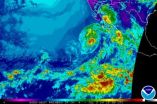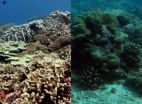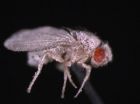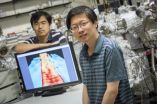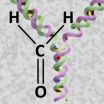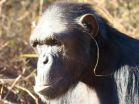(Press-News.org) Tropical Storm Douglas is on a weakening trend, according to the National Hurricane Center, and satellite imagery showed that the storm appeared more elongated on July 3.
NOAA's Geostationary Operational Environmental Satellite or GOES-West satellite captured visible data on Douglas just after sunrise on July 3 at 13:15 UTC (9:15 a.m. EDT). The data from GOES-West was made into an image at NASA/NOAA's GOES Project at the NASA Goddard Space Flight Center in Greenbelt, Md.
Forecaster Stewart at the National Hurricane Center cited that Douglas' thunderstorm activity had been gradually waning during the early morning hours on July 3 and infrared data, such as that from the Atmospheric Infrared Sounder instrument aboard NASA's Aqua satellite showed that cloud tops were warming, which indicates cloud heights were falling and the uplift of air in the storm was weakening. Despite that, microwave satellite data from NOAA's AMSU instrument and NASA's Tropical Rainfall Measuring Mission satellite indicated that Douglas had maintained a tight low-level circulation including a shallow eye-like feature.
On July 3 at 5 a.m. EDT (9:00 UTC), Douglas' maximum sustained winds were near 40 mph (65 kph) and the storm was weakening. The center of Douglas was located near latitude 20.4 north and longitude 116.5 west, about 455 miles (735 km) west-southwest of the southern tip of Baja California, Mexico. Douglas is moving toward the northwest near 3 mph (6 kph).
The NHC expects Douglas to become a tropical depression late on July 3 and degenerate into a remnant low pressure area by the fourth of July.
INFORMATION:
Tropical Storm Douglas weakening in the eastern Pacific
2014-07-03
ELSE PRESS RELEASES FROM THIS DATE:
Rethinking the reef
2014-07-03
A new study by biologists at San Diego State University and Scripps Institution of Oceanography shows that inhabited coral islands that engage in commercial fishing dramatically alter their nearby reef ecosystems, disturbing the microbes, corals, algae and fish that call the reef home.
The study's lead author, Linda Wegley Kelly, is a postdoctoral scholar in the lab of SDSU virologist Forest Rohwer.
For the study, she looked at seawater samples collected from the surfaces of reefs surrounding all 11 of the Line Islands, a chain of atolls in the central Pacific Ocean. ...
Fruit fly immunity fails with fungus after (space)flight
2014-07-03
Before you swat away the next fruit fly, consider instead just how similar its biological complexities are to our own. In a study published in PLOS ONE, researchers led by Deborah Kimbrell, Ph.D., at the University of California, Davis (UC Davis) and their collaborators, studied how microorganisms may alter fruit flies' immunity in space and in hypergravity, or increased gravity. The article is titled "Toll Mediated Infection Response Is Altered by Gravity and Spaceflight in Drosophila."
This study suggests that having normal gravity or hypergravity on the space station ...
Drug shows promise for effectively treating metabolic syndrome
2014-07-03
(SALT LAKE CITY)—University of Utah researchers have discovered that an enzyme involved in intracellular signaling plays a crucial role in developing metabolic syndrome, a finding that has a U of U spinoff company developing a drug to potentially treat the condition.
The researchers, led by Jared Rutter, Ph.D., professor of biochemistry, hope to begin human clinical trials of a drug in the next couple of years.
"The approved drug therapies do not treat or prevent this condition in most people," says Rutter, senior author of a study describing the research published ...
With 'ribbons' of graphene, width matters
2014-07-03
MILWAUKEE – Using graphene ribbons of unimaginably small widths – just several atoms across – a group of researchers at the University of Wisconsin-Milwaukee (UWM) has found a novel way to "tune" the wonder material, causing the extremely efficient conductor of electricity to act as a semiconductor.
In principle, their method for producing these narrow ribbons – at a width roughly equal to the diameter of a strand of human DNA – and manipulating the ribbons' electrical conductivity could be used to produce nano-devices.
Graphene, a one-atom-thick sheet of carbon atoms, ...
Bone marrow fat tissue secretes hormone that helps body stay healthy
2014-07-03
ANN ARBOR, Mich. — It has been known for its flavorful addition to soups and as a delicacy for dogs but bone marrow fat may also have untapped health benefits, new research finds.
A University of Michigan-led study shows that the fat tissue in bone marrow is a significant source of the hormone adiponectin, which helps maintain insulin sensitivity, break down fat, and has been linked to decreased risk of cardiovascular disease, diabetes, and obesity-associated cancers. The findings appear in today's online-ahead-of-print issue of Cell Metabolism.
Bone marrow adipose ...
NASA sees Hurricane Arthur's cloud-covered eye
2014-07-03
When NASA's Aqua satellite passed over Tropical Storm Arthur on July 2 at 2:50 p.m. EDT on July 2, it saw a cloud-covered eye as the storm was on the way to becoming a hurricane.
This visible image of Tropical Storm Arthur was captured by the Moderate Resolution Imaging Spectroradiometer or MODIS instrument that flies aboard NASA's Aqua satellite. Arthur's center was over the Atlantic Ocean and east of Florida's northeast coast. By 5 a.m. EDT on July 3, Arthur's eye had formed but remained cloud covered even as the storm hit hurricane-strength with maximum sustained ...
Cellular defence against fatal associations between proteins and DNA
2014-07-03
This news release is available in German.
DNA - the carrier of genetic information - is constantly threatened by damage originating from exogenous and endogenous sources. Very special DNA lesions are DNA-protein crosslinks - proteins covalently linked to DNA. So far hardly anything was known about repair mechanisms specifically targeting DNA-protein crosslinks. Stefan Jentsch's team at the Max Planck Institute of Biochemistry in Martinsried, Germany, now discovered a protease that is able to chop down the protein component of DNA-protein crosslinks, thereby enabling ...
'Grass-in-the-ear' technique sets new trend in chimp etiquette
2014-07-03
Chimpanzees are copycats and, in the process, they form new traditions that are often particular to only one specific group of these primates. Such are the findings of an international group of scientists, who waded through over 700 hours of video footage to understand how it came about that one chimpanzee stuck a piece of grass in her ear and started a new trend, and others soon followed suit. The findings of the study, led by Edwin van Leeuwen of the Max Planck Institute for Psycholinguistics in The Netherlands, are published in Springer's journal Animal Cognition.
In ...
GW researchers: Acute kidney injury and chronic kidney disease as interconnected syndromes
2014-07-03
WASHINGTON (July 3, 2014) — For more than 40 years, physicians have treated diminished kidney function as two distinct syndromes: acute kidney injury (AKI) and chronic kidney disease (CKD). However, recent epidemiologic and mechanistic studies suggest the two syndromes are not distinct entities, but interconnected. Published today in The New England Journal of Medicine, George Washington University (GW) researchers call for greater follow-up care of patients with AKI, who often present with CKD later in life, and vice versa.
"Our teaching has been wrong and the approach ...
Weighing up the secrets of African elephant body fat
2014-07-03
A research team from The University of Nottingham has carried out the first molecular characterisation of the African elephant's adipose tissue — body fat. This new information will form the basis of future studies aimed at securing the health and future survival of captive elephants.
The population of captive elephants, both Asian and African, in Europe and North America is not self-sustaining, largely due to poor fertility, resulting in a fewer baby elephants being born. It is acknowledged that if a solution for these reproductive difficulties cannot be found quickly, ...
